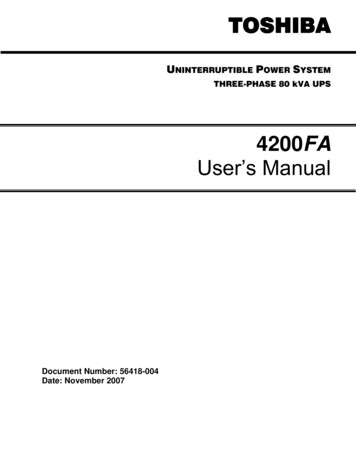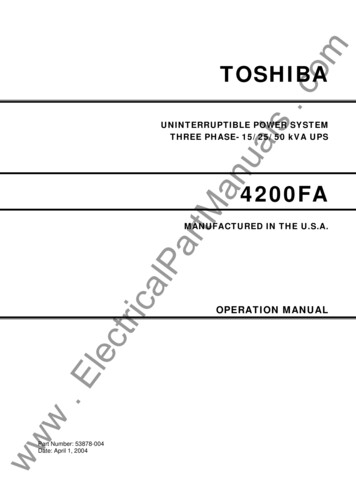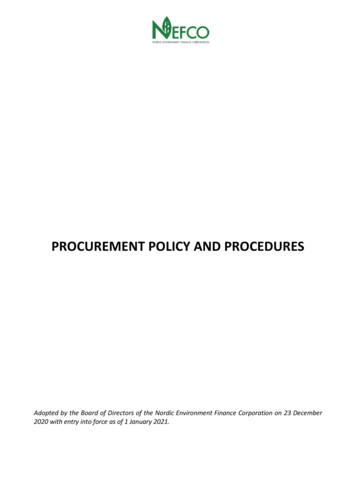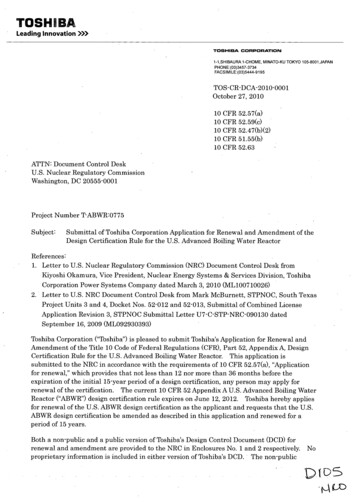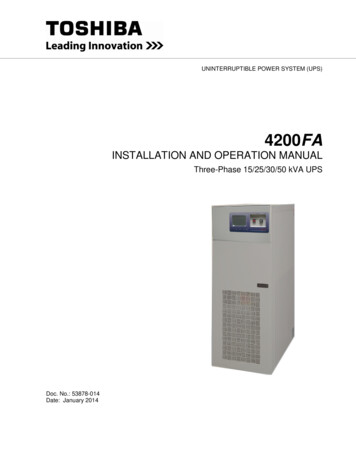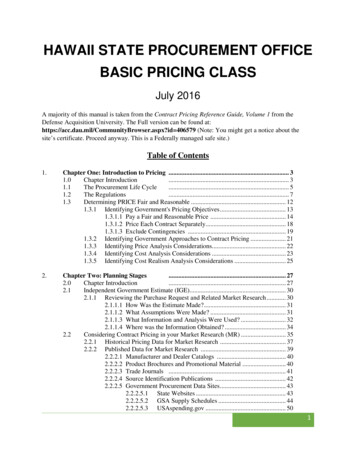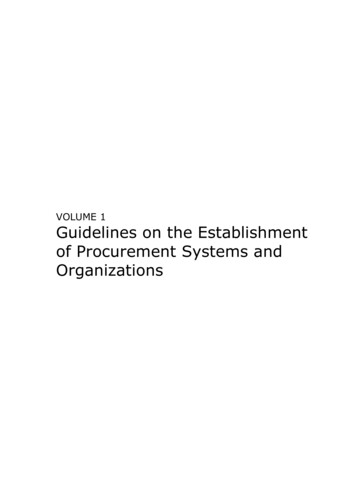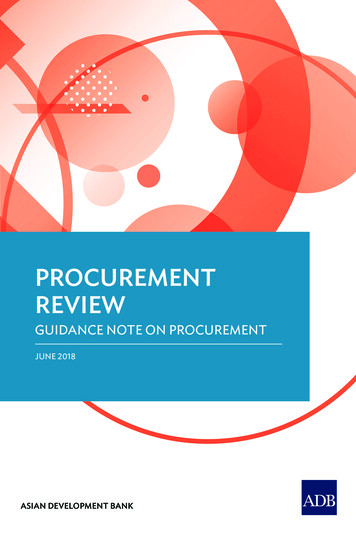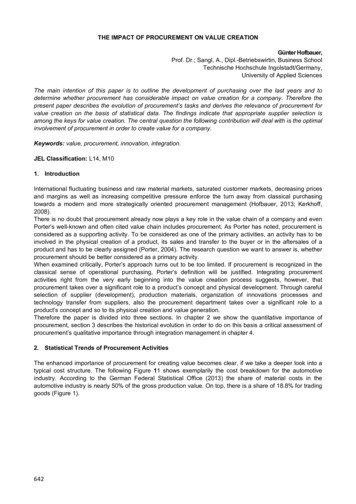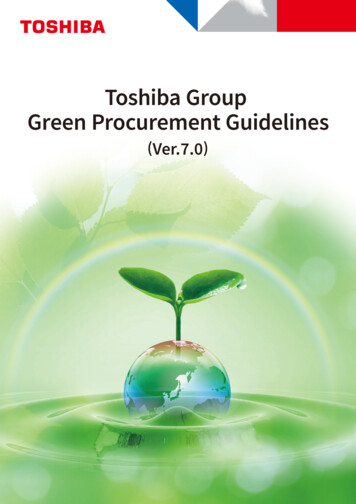
Transcription
Toshiba GroupGreen Procurement Guidelines(Ver.7.0)
Table of Contents1. Foreword2. Toshiba Group's Environmental Future Vision 20503. Purpose of Green Procurement4. Scope of Application of Green Procurement5. Requests to Suppliers5.1 Promotion of environmental management in accordance with Toshiba Group'sProcurement Standards(1) Construction of an environmental management system(2) Formulation of a basic environmental policy(3) Promotion of environmental impact reduction activities(a) Response to climate change(b) Response to the circular economy(c) Consideration of ecosystems(d) Other management items(4) Promotion of management of chemical substances in products delivered to ToshibaGroup(a) Construction of a management system for chemical substances in supply items(b) Management of chemical substances in supply items5.2 Conclusion of agreements for assuring the environmental quality of supply items5.3 Cooperation in surveys(1) Evaluation of suppliers' environmental management(2) Surveys of chemical materials/substances in supply items(3) Other surveys necessary to ensure "5.1 Promotion of environmental management inaccordance with Toshiba Group's Procurement Standards" above Appendix 1 Toshiba Group List of Environment-Related Materials/Substances (in Products)Rank A: Prohibited materials/substances Appendix 2 Toshiba Group List of Environment-Related Materials/Substances (in Products)Rank B: Managed materials/substances-1-
1. Foreword"Committed to People, Committed to the Future." is the long standing Basic Commitment of ToshibaGroup, a statement that expresses our enduring credo to contribute to the development of societythrough our business. Since our founding, with the venture spirit that has inspired Toshiba for manygenerations, our purpose has been to combine the power of invention with our expertise and desire for abetter world, to tackle increasingly complex and serious social issues, and to turn on the promise of anew day.It is essential for Toshiba Group to contribute to resolving environmental issues and other social issueswith our highly reliable products and services, thereby realizing a sustainable society, and to furtherincrease corporate value. To achieve these goals, we believe that it is important to respond to globaltrends from a long-term viewpoint.Based on this idea, Toshiba Group has formulated "Environmental Future Vision 2050" as a new long-termvision from a global perspective that responds to such issues as carbon neutrality and the transition to acircular economy. With the goal of "contributing to the realization of a sustainable society throughenvironmental management which aims to create enriched value and to ensure harmony with the earth,"it aims to realize a sustainable society—in other words, a decarbonized society, a resource circulatingsociety, and a society in harmony with nature—by promoting the implementation of initiatives in threeareas: "response to climate change," "response to the circular economy," and "consideration ofecosystems." Toshiba Group considers "response to climate change" in particular to be our top prioritytask for the Group's environmental management, and we aim to achieve carbon neutrality throughoutthe entire value chain by FY2050. This vision is in line with Toshiba Group's Basic Policy for theEnvironment and represents the ideal situation for 2050 as envisioned by the Group.To realize Environmental Future Vision 2050, it is essential to consider the environment throughout theentire supply chain. Green procurement, which involves procuring products, parts and components, andmaterials and services, etc. with minimal environmental impacts from suppliers that proactively promoteenvironmental management, is a high priority initiative for Toshiba Group. The Guidelines presentToshiba Group's basic concept of green procurement and the specific content of our requests tosuppliers. We invite our suppliers to work hand in hand with us to make green procurement aresounding success.Procurement Division Procurement Control & Compliance Promoting DivisionCorporate Production Planning Division Environment Management OfficeToshiba Corporation-2-
2. Toshiba Group's Environmental Future Vision 2050With the goal of "contributing to the realization of a sustainable society through environmentalmanagement which aims to create enriched value and to ensure harmony with the earth," ToshibaGroup's long-term environmental vision, Environmental Future Vision 2050, aims to realize a sustainablesociety—in other words, a decarbonized society, a resource circulating society, and a society in harmonywith nature. As for specific areas of activities, we have selected response to climate change and resourceissues in both business activities and products and services, management of water resources andchemical substances, and conservation of biodiversity. Under "response to climate change," we aim toachieve carbon neutrality throughout the Group's entire value chain by FY2050. As a milestone, we aim toreduce GHG emissions by 70% by FY2030 compared to the FY2019 level.To achieve the Vision, we have formulated Environmental Action Plan and are promoting activities in theselected areas and managing progress while reviewing the Plan every few years. Toshiba Group's Environmental Future Vision 2050Toshiba Group's Environmental Future Vision porate/vision/vision2050.html-3-
Breakdown of Greenhouse Gas Reduction Targets Toward Carbon Neutrality Toshiba Group's Environmental Action porate/vision/plan2.html3. Purpose of Green ProcurementIn collaboration with our suppliers, Toshiba Group aims to procure products, parts and components, andmaterials and services, etc. with minimal environmental impacts from suppliers that proactively promoteenvironmental management. Through such efforts, we will create environmentally conscious productsand services that contribute to reducing environmental impacts throughout their life cycles, therebycontributing to the realization of a sustainable society —in other words, a decarbonized society, aresource circulating society, and a society in harmony with nature, as envisioned in EnvironmentalFuture Vision 2050.4. Scope of Application of Green ProcurementThe Guidelines apply to all products, parts and components, and materials, etc. (hereinafter collectivelyreferred to as "supply items") to be delivered as well as services to be provided to Toshiba Group.-4-
5. Requests to SuppliersThis section describes specific requests to suppliers. We request that suppliers engage in activities inaccordance with the Green Procurement Standards defined by Toshiba Group as well as to concludeagreements with us for assuring environmental quality of supply items and to cooperate in varioussurveys. We also ask our suppliers to request their suppliers to understand the Guidelines and to promoteactivities accordingly. Due to industry trends and other circumstances, the details of requests to suppliersmay differ among Toshiba Group companies, so check the Green Procurement Guidelines issued by theoffice in charge of procurement of the relevant Toshiba Group company, division, operations, complex,factory, etc. Such Green Procurement Guidelines shall take precedence over those described in thisdocument.5.1 Promotion of environmental management in accordance with ToshibaGroup's Procurement StandardsWe will prioritize transactions with suppliers who more actively promote environmental management inaccordance with the following procurement standards defined in connection with Environmental FutureVision 2050 (*1).(1) Construction of an environmental management systemThe company has constructed an environmental management system in accordance withISO14001:2015 or equivalent and has obtained or is preparing to obtain a third-party certification.(2) Formulation of a basic environmental policyThe company has established its own basic environmental policy that describes the company'sthoughts on the environment in detail and has shared this basic policy within the company.(3) Promotion of environmental impact reduction activitiesThe company is engaging in the following activities to reduce environmental impacts that arerelated to "response to climate change," "response to the circular economy," and "considerationof ecosystems," which are the initiatives of Environmental Future Vision 2050.(a) Response to climate change(a)-1Has set the company's own GHG emissions reduction target(s) for Scope 1 (*2) andScope 2 (*3) and is managing progress.(a)-2Has set a GHG emissions reduction target for Scope 3 (*4), which refers to emissionsfrom other companies related to the company's activities, and is managing progress.(a)-3Has set a target aimed at achieving carbon neutrality within the company or its valuechain.(a)-4Discloses information on (a)-1, (a)-2, and/or (a)-3 above to parties outside thecompany.(a)-5Has requested that the company's primary suppliers reduce their GHG emissions.(b) Response to the circular economy(b)-1Has set (quantitative and/or qualitative) activity target(s) for waste management inthe company's business activities and is managing progress.(b)-2Is endeavoring to reduce waste from the company's business activities.-5-
(b)-3Has set (quantitative and/or qualitative) activity target(s) for resource managementregarding products and services that the company manufactures or provides as wellas packing and packaging materials, and is managing progress (*5).(b)-4Is working to save or reuse resources regarding products and services that thecompany manufactures or provides as well as packing and packaging materials.(c) Consideration of ecosystems(c)-1Has set (quantitative and/or qualitative) activity target(s) for chemical substancemanagement in the company's business activities and is managing progress (*6).(c)-2Has set (quantitative and/or qualitative) activity target(s) for chemical substancemanagement regarding products and services that the company manufactures orprovides, and is managing progress (*7).(c)-3Has set (quantitative and/or qualitative) activity target(s) for proper management ofwater resources in the company's business activities and is managing progress (*8).(c)-4Has set (quantitative and/or qualitative) activity target(s) for the company'sbiodiversity conservation activities and is managing progress (*9).(d) Other management items(d)-1Has constructed a management system for environmental risks, and has proceduresin place for preventive and corrective measures (*10).(d)-2Provides employees with environment-related education, including on legalcompliance management (*11).(4) Promotion of management of chemical substances in products delivered toToshiba GroupThe company is conducting the following activities to promote delivery of products as well asparts and components, etc. with minimal environmental impacts.(a) Construction of a management system for chemical substances in supplyitemsThe company has established response procedures in the event of non-compliance, etc. withrespect to its chemical substance management regulations, etc.; has ensured that all partiesconcerned in the organization are aware of such procedures; and thoroughly investigates thecauses and implements recurrence prevention measures.(b) Management of chemical substances in supply itemsThe company is aware of the two categories, namely "Rank A (Prohibitedmaterials/substances)" and "Rank B (Managed materials/substances)" (listed in the tablebelow) defined by Toshiba Group for the purpose of managing chemical substances in supplyitems, and manages chemical substances belonging to each of these categories inaccordance with Toshiba Group List of Environment-Related Materials/Substances (inProducts). (Appendix 1, Appendix 2).-6-
Two categories of chemical substance managementCategoryRank A (Prohibitedmaterials/substances)Rank B ubstancesMaterials/substances whose presence is Appendix 1prohibited in procurement items(including packaging) in Toshiba Group.Materials/substances whose use inproducts (including packaging) isprohibited or restricted by domestic andforeign laws and regulations.Materials/substances whoseAppendix 2environmental impact should be reduced,based on their actual usage, via reductionof use and substitution, or recovery anddetoxification in a closed system.5.2 Conclusion of agreements for assuring the environmental quality ofsupply itemsTo ensure the environmental quality of supply items, we request each supplier to conclude a QualityAssurance Agreement prior to transactions. In addition, we may request a supplier to submit anAgreement Concerning the Restriction of the Use of Specified Hazardous Substances as necessary.5.3 Cooperation in surveysTo confirm the status of suppliers' initiatives concerning "5.1 Promotion of environmental managementin accordance with Toshiba Group's Procurement Standards" above, we ask suppliers to cooperate invarious surveys, including regarding the following items:(1) Evaluation of suppliers' environmental managementTo strengthen partnerships with suppliers that are proactively engaged in environmentalmanagement activities, we periodically evaluate the status of environmental managementactivities by suppliers. We determine ranks based on the response results, and we prioritizeprocurement from suppliers who are rated highly. For suppliers with low ratings, Toshiba Groupmay plan remediation activities, make requests for remediation, and provide guidance andassistance. In addition, if a supplier does not make improvements according to the remediationplan despite receiving a request for remediation and the provision of guidance and assistance, wemay stop transactions with said supplier.(2) Surveys of chemical materials/substances in supply itemsPrior to the approval of new procurement items from suppliers and judgment as to whetherexisting procurement items require substitution, we conduct surveys concerning the presence ofthe chemical materials/substances in procurement items. The main items of the surveys are asfollows: Confirmation of the non-use of prohibited materials/substances via the "Declaration ofUse/Non-use of Environment-Related Materials/Substances (in Products)" Survey on the use/non-use and content of any substance of very high concern (SVHC, *12) to bea candidate for authorization under the EU REACH Regulation (chemSHERPA , *13) Survey on the analysis and evaluation results-7-
(3) Other surveys necessary to ensure "5.1 Promotion of environmentalmanagement in accordance with Toshiba Group's Procurement Standards"above*1:Standard items may differ depending on the supplier's business category, supply item type, necessity, etc. In addition,standard items are subject to change. For the details of the latest standard items, refer to the Green ProcurementGuidelines issued by the relevant Toshiba Group company, division, operations, complex, etc.*2:Direct emissions from owned or controlled sources (e.g., fuel combustion and industrial iles/standards/ghg-protocol-revised.pdf*3:Indirect emissions from the generation of purchased energy (e.g., electricity, heat, or /standards/ghg-protocol-revised.pdf*4:All indirect emissions (not included in scope 2) that occur in the value chain of the reporting company, including bothupstream and iles/standards/ghg-protocol-revised.pdf*5:The amount of resources saved and plastic resources recycled in products manufactured or provided by the company aswell as packing and packaging materials, promotion of circular economy businesses, etc.*6:The amount of chemicals emitted during the company's business activities.*7:Management of specified chemical substances contained in products manufactured or provided by the company.*8:The amount of water received, waste water recycled, rain water used, etc.*9:Biodiversity conservation activities in and outside production or business sites, etc.*10: Development and formulation of company-wide policies and regulation on environment-related legal compliancemanagement, and implementation of legal compliance management in accordance with such policies and regulations.*11: Promotion of awareness-raising education on legal compliance, including sharing of the latest trends in legal regulations,the company's environmental risk management system, and case studies on accidents that have occurred within thecompany, etc.*12: Substance of Very High Concern (SVHC). Substances that fall under the criteria defined in Article 57 of the EU REACHRegulation and that have been selected as candidate substances for authorization according to the procedure defined inArticle 59 of said regulation.*13: A scheme for communicating information on the chemical substances contained in products; this scheme is availableacross the supply chain.-8-
Appendix 1 Toshiba Group List of Environment-Related Materials/Substances (in Products)Rank A: Prohibited materials/substancesNo.Material/substance categoryA01 AsbestosA02 Certain azocolourants andazodyes (only those that mayrelease certain amines)A03 Cadmium and cadmiumcompoundsA04 Hexavalent chromiumcompoundsA05 Lead and lead compoundsA06 Mercury and mercurycompoundsA07 Ozone depleting substances(CFCs, HCFCs, HBFCs, carbontetrachloride, etc.)A08 Polybrominated biphenyls(PBBs)A09 Polybrominateddiphenylethers (PBDEs)A10A11A12A13A14Threshold of concentration to beprohibited in supplies toReference laws and regulationsToshiba GroupProhibition of intentional addition EU REACH Regulation (Annex XVII),JPN Industrial Safety and HealthLaw (Prohibition of Manufacturing)0.003wt% (30 ppm) for eachEU REACH Regulation (Annex XVII)generated certain Amine0.01wt% (100 ppm) (*1, 2)EU RoHS Directive,EU REACH Regulation (Annex XVII),EU Packaging Directive0.1wt% (1000 ppm) (*1, 2)EU RoHS Directive,EU REACH Regulation (Annex XVII),EU Packaging Directive0.1wt% (1000 ppm) (*1, 2)EU RoHS Directive,EU REACH Regulation (Annex XVII),EU Packaging Directive0.1wt% (1000 ppm) (*1, 2)EU RoHS Directive,EU REACH Regulation (Annex XVII),EU Packaging DirectiveProhibition of intentional addition Montreal Protocol,JPN Ozone Layer Protection Law0.1wt% (1000 ppm) (*1)EU RoHS Directive,EU REACH Regulation (Annex XVII)Prohibition of intentional addition JPN CSCL (Class 1) (*7)(only for 4-7, 10 bromine atoms), U.S. TSCA PBT Rules (*8)or 0.1wt% (1000 ppm) (*1)EU RoHS DirectivePolychlorinated biphenylsProhibition of intentional addition JPN CSCL (Class 1) (*7)(PCBs)EU REACH Regulation (Annex XVII),EU POPs RegulationPolychlorinated naphthalenes Prohibition of intentional addition JPN CSCL (Class 1) (*7)(more than 1 chlorine atoms)EU POPs Regulation(*3)Radioactive substancesProhibition of intentional addition JPN Act on Prevention of RadiationHazards due to Radioisotopes, etc.JPN Nuclear Reactor RegulationLawCertain short chainProhibition of intentionalJPN CSCL (Class 1) (*7),chlorinated paraffins (with aaddition, or 0.1wt% (1000 ppm)EU POPs Regulationcarbon chain length ofbetween 10 and 13)Tributyl tin (TBT) and triphenyl 0.1wt% (1000 ppm) of tin in theEU REACH Regulation (Annex XVII)tin (TPT)part (*4)-9-
No.Material/substance categoryA15 Tributyl tin oxide 2-il)4,6-di-tert-butylphenol (UV320)(deleted)(deleted)(deleted)Perfluoro (octane-1-sulfonicacid) (also known as PFOS) orits saltA38 Perfluoro (octane-1-sulfonyl)fluoride (also known asPFOSF)A39 Polychlorinated terphenyls(PCTs)A40 Tri-substituted organostanniccompounds (excluding A14and A15)A41 Dimethyl fumarate (DMF)A42 (deleted)A43 (deleted)A44 (deleted)A45 (deleted)A46 (deleted)Threshold of concentration to beprohibited in supplies toReference laws and regulationsToshiba GroupProhibition of intentionalJPN CSCL (Class 1) (*7),addition, or 0.1wt% (1000 ppm) of EU REACH Regulation (Annex XVII)tin in the part (*4)Prohibition of intentional addition JPN CSCL (Class 1) (*7)Prohibition of intentionaladdition, or 0.1wt% (1000 ppm)(in the case of coated material, 1microgram/m2)Prohibition of intentionaladdition, or 0.1wt% (1000 ppm)(in the case of coated material, 1microgram/m2)0.005wt% (50 ppm)JPN CSCL (Class 1) (*7),EU POPs Regulation0.1wt% (1000 ppm) of tin in thepart (*4)EU REACH Regulation (Annex XVII)0.00001wt% (0.1 ppm)EU REACH Regulation (Annex XVII)- 10 -JPN CSCL (Class 1) (*7)EU POPs RegulationEU REACH Regulation (Annex XVII)
No.Material/substance categoryA47 Dioctyltin compounds (DOT)A48 Dibutyltin compounds (DBT)A49 (deleted)A50 Hexabromocyclododecane(HBCD)A51 Certain polycyclic aromatichydrocarbons (PAHs)A52 Bis (2-ethylhexyl) phthalate(DEHP)A53 Dibutyl phthalate (DBP)A54 Butyl benzyl phthalate (BBP)A55 Diisobutyl Phthalate (DIBP)Threshold of concentration to beprohibited in supplies toReference laws and regulationsToshiba Group0.1wt% (1000 ppm) of tin in theEU REACH Regulation (Annex XVII)part (*4, 5)0.1wt% (1000 ppm) of tin in theEU REACH Regulation (Annex XVII)part (*4, 5)Prohibition of intentionaladdition, or 0.01wt% (100 ppm)0.0001wt% (1 ppm) of the plasticor rubber part (*5)0.1wt% (1000 ppm) (*6)JPN CSCL (Class 1) (*7),EU POPs RegulationEU REACH Regulation (Annex XVII)EU RoHS Directive,EU REACH Regulation(Annex XVII)0.1wt% (1000 ppm) (*6)EU RoHS Directive,EU REACH Regulation (Annex XVII)0.1wt% (1000 ppm) (*6)EU RoHS Directive,EU REACH Regulation (Annex XVII)0.1wt% (1000 ppm) (*6)EU RoHS Directive,EU REACH Regulation (Annex XVII)Prohibition of intentional addition U.S. TSCA PBT Rules (* 8)A56 Phenol, isopropylatedphosphate (PIP (3:1))A57 Perfluorooctanoic acid (PFOA), 1. PFOA and its saltsJPN CSCL (Class 1) (*7),its salts and relatedProhibition of intentional addition EU POPs Regulationcompoundsor 0.0000025wt% (25 ppb) ofPFOA including its salts in anarticle or a mixture2. PFOA-related compounds0.0001wt% (1 ppm) of one or acombination of PFOA-relatedcompounds, in an article or amixture"Intentional addition" means using chemical substances intentionally in forming supply items to bringabout specific properties, appearance, or quality.(*1) The denominator when calculating a threshold value shall be for each homogeneous material. The threshold concentrationof metal compound is the mass ratio of metal element to homogeneous material. For example, in the case of cadmium andits compounds, it is the concentration of cadmium element. Only applications exempt from the EU RoHS Directive(hereinafter RoHS) shall be exempt from the prohibition (including exemption applications accepted in the future).(*2) For packaging materials, the threshold of concentration to be prohibited shall be 0.01wt% (100 ppm) for a total of fourmaterials (cadmium and its compounds, hexavalent chromium compounds, lead and its compounds, and mercury and itscompounds) for each homogeneous material composing the package. The threshold concentration of metal compound isthe mass ratio of metal element to homogeneous material. For example, in the case of cadmium and its compounds, it isthe concentration of cadmium element.(*3) Polychlorinated naphthalene with 1 or more chlorine atoms is prohibited for products destined for the EU that requirecompliance with EU POPs regulations. Polychlorinated naphthalene with 2 or more chlorine atoms is prohibited forproducts for other regions.(*4) The numerator when calculating a threshold value shall be an equivalent for metal tin (Sn), and the denominator shall befor each molded item or its component (including mixtures only for DBT). Intentional addition for biocides and industrialwastewater treatment applications is prohibited.- 11 -
(*5) The target substance groups and uses are listed in Annex XVII of the EU REACH Regulation. However, only the applicationsallowed for use covered by the exemptions and time limits specified in Annex XVII of the EU REACH Regulation shall beexempt from the prohibition of use.(*6) In the case of the scope of the EU RoHS Directive, it is prohibited to contain 0.1wt% (1000 ppm) or more of eachhomogeneous material for each substance. In the case of the scope of the EU REACH Regulation, the total content ofphthalates is prohibited from containing 0.1wt% (1000 ppm) or more of the plasticized material. The applications that areout of scope of EU RoHS Directive or EU REACH Regulation, or are exempted from EU RoHS Directive or EU REACHRegulation shall be exempt from this regulation (including exemption applications accepted in the future).(*7) CSCL: Chemical Substances Control Law of Japan(*8) The regulations on the five persistent, bioaccumulative, and toxic (PBT) chemicals and PBT-containing products andarticles in accordance with the TSCA (U.S. Toxic Substances Control Act) Section 6(h). At the moment, procurement itemsthat are incorporated into articles whose destinations are clearly countries other than the U.S. are not subject to theregulations. In addition, among PIP (3:1), phase-in prohibitions and exemptions are excluded. Appendix 2 Rank B: Managed materials/substances 13B14B15B16Material/substance category(deleted)(deleted)(deleted)Brominated flame retardants, other than PBBs (A08) and PBDEs (A09)Nickel and its compounds (only parts in contact with human bodies)Certain phthalates, other than DEHP (A52), DBP (A53), BBP (A54), DIBP (A55) and designatedphthalates (B12)(deleted)(deleted)Perfluorocarbons (PFCs)Hydrofluorocarbons (HFCs)Sulfur hexafluoride (SF6)Substances of Very High Concern (SVHC) under the EU REACH Regulation (*9)(deleted)The U.S. TSCA PBT Rules (5 substances) (excluding DecaBDE (A09) andPIP (3:1) (A56)) (* 10)Next candidate substances for restriction under the EU RoHS DirectiveNext candidate substances for restriction under the Chemical Substances Control Law of JapanClass 1(*9) The Substances of Very High Concern (SVHC) selected under the procedures specified in Article 59 of the EU REACHRegulation. The denominator shall be the total mass of a supply item or each component/material.(*10) The regulations on the five persistent, bioaccumulative, and toxic (PBT) chemicals and PBT-containing products and articlesin accordance with the TSCA (U.S. Toxic Substances Control Act) Section 6(h). At the moment, procurement items that areincorporated into articles whose destinations are clearly countries other than the U.S. are not subject to the regulations.- 12 -
Table of revisionsEstablished on: December 1, 1999Revised on:June 1, 2003November 1, 2006May 1, 2011February 1, 2015January 1, 2017December 1, 2019February 1, 2021April 27, 2021November 1, 2021March 31, 202212Date of establishment/ 2021.11.17.02022.3.31Edition No.Reason and contents of revisionNewly issuedReviewed contents and coverage of the List of Environment-RelatedMaterials/Substances (in Products)Reviewed and totally revised the contents of the List of EnvironmentRelated Materials/Substances (in Products)Totally revised by reviewing the List of Environment-RelatedMaterials/Substances (in Products) and changing the control ofcontained chemical substances to the JAMPReviewed contents of the List of Environment-RelatedMaterials/Substances (in Products)1. Prohibited Materials/substances (category) (Appendix 1, Rank A):Revised annotation (*1) and (*2) and added (*5)2. Managed materials/substances (category) (Appendix 2, Rank B):Changed annotation from (*5) to (*6)1. Revised Toshiba Group's Basic Policy for the Environment2. Changed URL of JAMP3. Replaced MSDSplus and AIS form as examples with chemSHERPA 1. Revised Toshiba Group's Basic Policy for the Environment2. Revised the List of Environment-Related Materials/Substances (inProducts)Revised the List of Environment-Related Materials/Substances (inProducts) and the annotationsRevised the List of Environment-Related Materials/Substances (inProducts) and the annotationsAdded Purpose of Green Procurement and Scope of Application ofGreen Procurement based on Toshiba Group's Environmental FutureVision 2050; organized and integrated the Green ProcurementStandards and Requests in accordance with the Vision, etc.- 13 -
Committed to People, Committed to the Future.Toshiba Corporation1-1 Shibaura 1-chome, Minato-ku, Tokyo, 105-8001, JapanInquiry on Toshiba Group Green Procurement Guidelines :Corporate Production Planning Division Environment Management rporate/contact.htmlProcurement Division Procurement Control & Compliance Promoting corporate/contact.htmlIssued April 2022
ecosystems." Toshiba Group considers "response to climate change" in p articular to be our top priority task for the Group's environmental management, and we aim to achieve carbon neutrality throughout the entire value chain b y FY2050. This vision is in line with Toshiba G roup's Basic Policy for the
